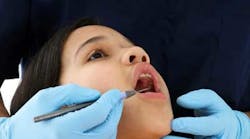ALSO BY CATHY HESTER SECKMAN | Motivating teens to better oral care through the use of dental technology
An ultrasonic unit and an air polisher can make orthodontic hygiene appointments easy, but not every hygienist has access to such tools. Owners of small offices may not want to or be able to provide all of the necessary equipment, and hygienists who are raising families and facing economic cuts can’t always afford to purchase their own equipment. Other, less expensive and less cumbersome options are available that can still help a hygienist reach her or his goals.
ALSO BY CATHY HESTER SECKMAN | Orthodontic tooth movement with clear aligners: seeing results with the invisible
A humble bottle of disclosing solution provides a starting point. Making plaque more visible will help aid removal. Modern hand instruments are another plus. Even if the boss is of the “what was good enough for my dad is good enough for us” persuasion, it might help to compare the cost of a new set of instruments with the cost of an air polisher. Newer instrument configurations make access easier than ever, and some stay sharp for their entire life span. With an American Eagle XP scaler or a Hu-Friedy EverEdge, for instance, distinguishing calculus from ortho cement is a simple task.
Using both buttons of an air/water syringe at full pressure works well for clearing plaque buildup from molar tubes or connected ligature elastics. Occasionally, the air/water blast will be able to clean under a palatal rest for a fixed appliance. Warn the patient ahead of time, and be ready with a paper towel.
Arch wires, the nemesis of every hygienist, effectively prevent flossing, but there are many adjuncts to make things easier for a hygienist. Butler Gum Soft-Picks and interdental cleaners work as well in the office as they do at home. Floss threaders come in many varieties to fit every type of access. Platypus flossers, which are U-shaped flossers with a flat spatula replacing one end of the U, were developed specifically to work around orthodontic hardware. The spatula is inserted under the arch wire so floss can contact the full interproximal area. At the opposite end of the flosser is a small brush that can be used to clean around brackets.
Polishing around appliances has always been the most difficult task for me, but it’s been much easier since I discovered 2Pro prophy angles. Made by NEXADENTAL, The 2Pro’s cup-on, cup-off design makes it perfect for working around orthodontic hardware. After polishing the lingual surfaces and any available labial surfaces with the 2Pro’s standard soft cup, grasp the cup between your fingers and pull it off. Presto chango! You have a rubber tip with which to complete your polishing. The tip fits very nicely above bands, even where the gingival is swollen, and can be used both above and below the arch wire, into the embrasures. With the handpiece running slowly, it’s even possible to circle each bracket. The rubber cup will pop right back over the tip if necessary.
These low-tech solutions take more time than a brisk session with an air polisher, but for calculus and plaque removal, they’re all you really need for a complete and satisfactory prophy appointment.
Photo credit: Dreamstime.com
Resources






